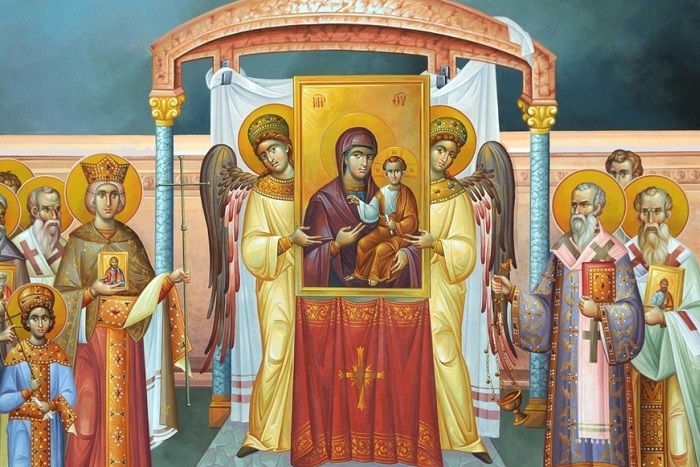
The Orthodox Church celebrates the Jewish Pascha as the antecedent of the Pascha of Christ. Because the Jewish Pascha preceded the Exodus of the Jews from Egypt, Biblical scholars concern themselves with the relevant and difficult task of dating the Exodus. On the one hand, we can find references to the date of the event in the text of the Bible, but are they consistent with the other historical data? Can we find any historical evidence to corroborate them? Modern historical dating of the Exodus differs from the date in the Bible. Multiple arguments and counter-arguments have been made regarding both. In this article, we consider the scriptural version of the dates of the Exodus.
Destruction of Jericho
The excavations in Jericho, one of Palestine’s oldest cities may offer some clues of relevance to the dating of the Exodus. Jericho was destroyed by the Jews. Canadian archaeologist Brian Wood concluded from the excavation findings that the approximate date of the destruction was 1400 BC, which is consistent with the biblical narrative. B. G. Did the Israelites conquer Jericho?). In his paper, he offers several arguments in support of the biblical version, including the results of radiocarbon analysis of the wood, which timed the event at ca. 1410, +/- 40 years. Cyprus ceramic dated at around the same period was found among the artefacts in the layers corresponding to the destruction of the city. Incidentally, it is not fully clear if it was the Jews who raised Jericho, as the city had also been at war several times with Egypt.
Biblical evidence
The main biblical text that states the date of the Exodus accurate for several decades is the Third Book of Kings with a narrative of the reign of King Solomon: “And it came to pass in the four hundred and eightieth year after the children of Israel came out of the land of Egypt, in the fourth year of the reign of Solomon over Israel, in the month Zio (the same is the second month), he began to build a house to the Lord.” (3 Kings 6:1). Accepting that King Solomon’s death occurred in circa 925 BC, and knowing that he reigned for forty years, it is easy to count backwards 480 years to the beginning of the building of the temple. This gives us the accepted biblical dating of the Exodus at approximately 1450 BC. Knowing the year and the succession of the Egyptian Pharaohs, we can tentatively determine the name of the Pharaoh under whom the exodus began.
Jews and slavery
It seems strange that no part of the Scripture gives the name of the ruling Pharaoh at the time of the Exodus, even though it is otherwise quite detailed in listing the names of many other characters, including the less significant ones. And this although Moses, would have known the Pharaoh by virtue of him being an adopted son of the Pharaoh’s daughter. (Exodus 3:10). Nor do the Egyptians, who normally recorded the most minute details of their history in their chronicles, make any mention of an event related to Exodus.
Assuming that the chronology of the Third Book of Kings is correct, the Pharaoh who presided over the oppression of the Jews would have been Thutmose III (1482 – 1450), who was also known for his grand construction projects and who mobilised many people, including Jews to do the works. Pharaoh’s servant Rekmar, whose burial vault was discovered in Thebes, oversaw the building of many of these objects (Urgen M. Archeology and Old Testament, P/ 142). Curiously, depictions of the makers of the bricks were found on the walls of the vault, with inscriptions that said “He provides us with bread, wine and all the other essentials” (Ibid) This brings to memory the lamentations of the Jews addressed to Moses: If only we had died by the Lord’s hand in Egypt! There we sat around pots of meat and ate all the food we wanted. (Exodus 16:3). Next to the guards, the following words were inscribed “I have a whip in my hand. Do not dare to slacken off. Archaeology and Old Testament, P. 143)
Which Pharaoh?
If the oppression of the Jews happened during the reign of Thutmose III, then the Pharaoh that reigned at the time of the Exodus would be his successor Amenhotep II (1450 – 1425), who was busy suppressing the revolts in the provinces against Egyptian rule. Related to the plague of the killing of the first-born children of Egypt is an inscription on the plate of red granite discovered a short distance away from the Sphinx, known as the dream of Thutmose IV. The text narrates that in his youthful years Thutmose had a vision of the Sphinx who commanded him to clear his statue from the sand and become Pharaoh. As follows from the context of this inscription, the ascent of Thutmose IV to the throne was fully unexpected. In turn, this might suggest that Thutmose may have had an older brother, son of Amenhotep II, the hopeful successor, who died for an unknown reason. He may have fallen victim to the tenth plague of Egypt.
We have reviewed the available body of archaeological evidence consistent with the biblical narrative. However, this evidence is still not robust enough to support conclusions of a dogmatic nature. Biblical archaeology is an evolving field, and new findings may easily overturn the existing datings and hypotheses not fully supported by the scriptural text. In the forthcoming part, we intend to review alternative evidence that supports an alternative estimate of the date of the Exodus, which is also worthy of consideration.




